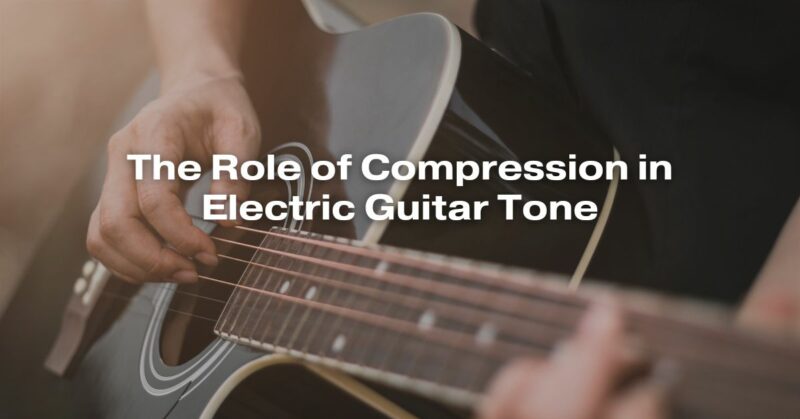Introduction
The electric guitar is an iconic instrument that has shaped the sound of music across various genres, from blues and rock to jazz and beyond. Musicians and guitarists have always sought ways to manipulate and refine their guitar tones to create distinctive sounds that stand out in the mix. One crucial tool in achieving this is the guitar compressor. Compression plays a significant role in shaping the electric guitar’s tone, enhancing sustain, controlling dynamics, and contributing to the overall character of the sound. In this article, we will explore the role of compression in electric guitar tone and how it can be used effectively to achieve desired sonic results.
Understanding Compression
Compression is an audio processing technique used to control the dynamic range of an audio signal. Dynamic range refers to the difference between the loudest and quietest parts of a sound. In the context of electric guitar, compression reduces the dynamic range by attenuating the louder peaks in the signal while simultaneously boosting the quieter portions. This results in a more consistent and controlled sound.
The Electric Guitar’s Dynamics
The electric guitar is a dynamic instrument. It can produce a wide range of volumes depending on how the strings are struck, the guitar’s pickups, and the player’s technique. While these dynamics are an essential part of the instrument’s expressiveness, they can sometimes create challenges in live or studio situations. Uncontrolled dynamics can lead to parts of the guitar performance getting lost in the mix or becoming too dominant. This is where compression comes into play.
Compression in Electric Guitar Tone
1. Sustain Enhancement: Compression can significantly enhance sustain, which is the length of time a note continues to sound after it’s played. By reducing the initial attack and boosting the sustain, compression allows notes to ring out for a longer duration. This is particularly useful for achieving singing lead guitar tones and lush, sustained chords.
2. Dynamics Control: As mentioned earlier, compression helps control the guitar’s dynamics. It evens out the volume disparities between loud and soft passages, making the guitar sound more consistent and polished. This is especially valuable in live performances where inconsistent dynamics can lead to problems with sound reinforcement.
3. Tonal Character: Compression can also influence the tonal character of the electric guitar. When used subtly, it can add warmth and smoothness to the sound, enhancing the harmonics and making the guitar sound more pleasing to the ears. Conversely, aggressive compression can introduce a gritty, edgy quality, which can be desirable in certain musical contexts.
4. Clean vs. Dirty Tones: Compression can be used to shape the transition between clean and distorted guitar tones. When applied before distortion, compression can help maintain clarity and note definition, even at high gain settings. On the other hand, placing compression after distortion can further shape the sustain and tonal characteristics of the distorted sound.
Types of Compression
There are various types of compressors available, each with its own characteristics and applications in shaping electric guitar tone. Here are a few common types:
1. Optical Compressors: Optical compressors use a light-dependent resistor (LDR) and a light source to control the compression. They are known for their smooth and transparent compression, making them ideal for maintaining the natural tone of the electric guitar.
2. FET Compressors: Field-effect transistor (FET) compressors are known for their fast attack times and can add a certain amount of coloration to the signal, often described as “vintage” or “warm.”
3. VCA Compressors: Voltage-controlled amplifier (VCA) compressors offer precise control over compression settings and are often used in studio applications for their flexibility.
4. Tube Compressors: Tube compressors incorporate vacuum tubes in their circuitry, which can introduce a warm and harmonically rich sound. They are favored for adding color and character to guitar tones.
Tips for Using Compression with Electric Guitar
1. Start with moderate settings: When using compression, it’s essential to start with conservative settings and gradually increase the compression ratio, threshold, and makeup gain to avoid over-compression, which can result in a lifeless sound.
2. Experiment with pedal placement: The placement of the compressor pedal in your signal chain can affect the overall tone. Placing it before overdrive or distortion pedals can yield different results than placing it after.
3. Use parallel compression: Parallel compression, also known as New York compression, involves blending the compressed and dry signals. This technique can help maintain the natural dynamics while adding sustain and control.
4. Match the compressor to your playing style: The choice of compressor should align with your playing style and musical genre. For example, subtle compression may suit jazz and blues, while more aggressive compression can be suitable for rock and metal.
5. Listen critically: Always use your ears as the ultimate guide. Pay attention to how compression affects your guitar tone and adjust settings accordingly to achieve the desired sound.
Conclusion
Compression plays a crucial role in shaping the electric guitar’s tone by enhancing sustain, controlling dynamics, and contributing to its overall character. Whether you’re aiming for a clean, smooth sound or a gritty, edgy tone, understanding how to use compression effectively is an essential skill for any guitarist. By experimenting with different compressors, pedal placements, and settings, you can unlock new dimensions of expression and creativity in your guitar playing. Ultimately, the art of using compression is about finding the balance that complements your playing style and serves the musical context in which you perform or record.

